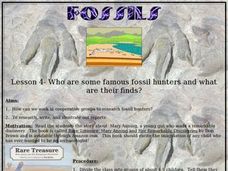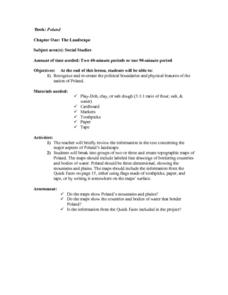Curated OER
Franklin Mountains
Fifth graders examine photographs of the eastern and western Franklin Mountains. As a class, they discuss what is shown and the different colored rocks and the orientation of the layers. In groups, they are given clay of two different...
Curated OER
Yeasts and Molds
Students investigate the characteristics and nature of yeast and molds help to explain how these microorganisms affect food production. They experiment with yeast in sourdough in preparing sourdough pancakes.
Curated OER
Being Thrifty is So Nifty
Students watch a video that focusing on budgeting while completing worksheets that include charts. They brainstorm ideas for budgeting time and money. They culminate the activity by planning an order from two different restaurants.
Curated OER
Foods and Languages of the World
Students learn about the foods of Italy. In this Italy lesson, students learn about the different types of food from Italy, create their own pizzas using paper and markers, share their pizzas with the class, and go to the cafeteria and...
Curated OER
Fossils Lesson 4 - Who Are Some Famous Fossil Hunters and What Are Their Finds?
Students research and develop a presentation about a famous fossil hunter/archaeologist. In this fossil hunter/archaeologist lesson, students listen to a reading of Don Brown's, Rare Treasure: Mary Anning and Her Remarkable Discoveries....
Curated OER
Understanding Lava Layers
Seventh graders trace the lava flow of an erupting volcano. In this earth science lesson plan, 7th graders experiment using baking soda and vinegar. They record and share their observations.
Curated OER
Why Does the Bulb Light When There is Flow?
Learners analyze light bulbs and their design. They create filaments and build a circuit for testing the filaments. Through experimentation, students discover how filament wire works. They explore the role of protons, electrons, and...
Curated OER
Leaf Observations
Second graders examine a variety of leaves. In groups or individually, they write down their observations on each leaf type and compare them to each other. To end the lesson, they share their observations with the class and draw the...
Curated OER
Beginning Sounds
Students sit in a circle and repeat the names and sounds of the first letter of their first names. Next, they trace their name once on the practice paper and then practice writing their name on the other lines. Then they observe the...
Curated OER
Spider Webs
Students create spider webs. In this spider webs instructional activity, students research various types of spider webs then write a report about a spider of their choice. Students also make their own web similar to an orb...
Curated OER
Double or More
Students practice cooking by following recipe instructions. In this measuring instructional activity, students read food recipes and collect the materials needed to make one batch, then double the recipe to create twice as much...
Curated OER
What's Crackin' Under New Zealand
Students construct a model of the Earth using clay and oranges. In this earth science lesson, students explain the causes of earthquakes and volcanic activity. They write their findings in their science journal.
Curated OER
Cookie Fun
Students make cookies to celebrate the May Day holiday. They discuss the significance of May Day, listen to the book "If You Give a Mouse a Cookie" by Laura Numeroff, and decorate cookies with spring colors. Students also create a card...
Curated OER
T Letter Ideas
Students participate in activities that begin with the letter "T". They also expand their vocabulary.
Curated OER
How the cookie crumbles
Students break cookies in half and compare them with their partner's half and eat it when they have decided that they have equal parts. In this equal parts lesson plan, students decide if they have equal amounts or not.
Curated OER
Animal Habitats
Students explore animal lifestyles by researching their characteristics. For this animal habitat lesson, students read the story Over in the Jungle and analyze the animal illustrations in the book. Students create clay animal characters...
Curated OER
Yeasts and Molds: Food Science, Bacteria, Fungi
In this lesson students will consider the characteristics and nature of yeast and molds in order to help them understand how these microorganisms affect food production.
Curated OER
Greece: The Landscape
Students work in small groups to create a topographic map of Greece. They must include labeled line drawings of bordering countries and bodies of water. Students use salt and flour clay to make Greece three dimensional, showing the many...
Curated OER
The Landscape of Poland
Students recognize and re-create the political boundaries and physical features of the nation of Poland. They create three dimensional topographic maps of Poland. In addition, they compose two journal entries written in two different...
Curated OER
The Landscape
Students recognize and recreate the political boundaries and physical features of the nation of Slovakia. They create topographic maps of Slovakia. The maps should include labeled line drawings of bordering countries. Slovakia should be...
Curated OER
Mud Tortillas
First graders read a story entitled, "Mud Tortillas." After reviewing the book, 1st graders predict what will happen. They review methods and strategies for decoding unfamiliar words. A Venn diagram is created for students to compare...
Curated OER
Microorganism Multiplication
Seventh graders complete two experiments to learn about harmful and helpful microorganisms. In this microorganisms lesson, 7th graders read background information about fungi, yeast, and club fungi. Students then complete two experiments...
Curated OER
United Kingdom
Middle schoolers investigate the geographical features of the United Kingdom. They create a clay, playdoh, or salt and flour map of the region. The maps should be labeled with landmarks and bodies of water. They can also draw maps on...
Curated OER
Flags
Students read You're a Grand Old Flag as well as other provided books about flags. In this flag lesson plan, students cut, decorate and bake cookies as flags, practice the letter f, the number 4, the rectangle shape and use the color...
Other popular searches
- Mixing Colors Play Dough
- Play Dough Math
- Rock Cycle Play Dough
- Activities With Play Dough
- Play Dough Activities
- Making Play Dough
- Play Dough Sculptures
- Play Dough Models
- Play Dough Economics
- Play Dough Math Patterning
- Play Dough Neuron
- Play Dough Lesson Plans

























